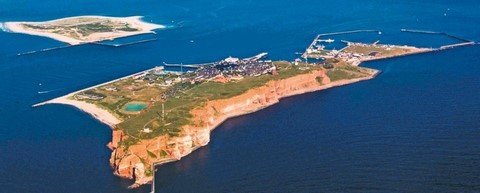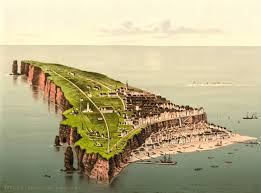Blood-red flint tools - souvenirs of Doggerland?
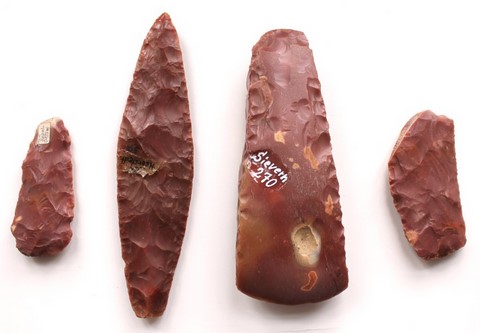
When it came to stone tools and weapons, some ancient Europeans seem to have had a marked preference for the red flint from the Island of Heligoland, in the North Sea. People put their lives at risk in order to obtain it. Was it because of the red color – or because it went back to the lost paradise of Doggerland?
The North Sea island of Heligoland has something which exists almost nowhere else on Earth: red silex. We are not talking about the red sandstone which constitutes the island‘s bedrock, but remarkable, rust-red stones: they originated in dead-waters which sloshed there around 90 million years ago: in the oxygen-deprived water, a lot of iron-oxyd was deposited – coloring red the silica, from which the silex (flint) was later formed.
Humans always seem to have had a foible for beautiful stones. And the red stones of Helgoland appear to have been much in demand for all kinds of tools and weaponry: sickles, axes, daggers. Daniel Nösler, district-archaeologist of Stade, a former Hansa city in Lower Saxony, is turning around in his hands an ax made of the red Heligoland flint.
"This shape with the curved, narrow sides is typical of early copper axes, which appeared in the Late Neolithic. Possibly, someone here wanted to imitate what was then a new and very rare material: copper. Not only the shape, but also the color had to be right: red."
The end of Doggerland

Yet the ax was not found in Heligoland, but on the Wehrberg near Duhnen, close to the city of Cuxhaven. From the mouth of the Elbe River, where Cuxhaven is situated, there are 62 kilometers all the way to Heligoland. If you want to reach the island from land, you must cross a considerable stretch of open water – without any sight-contact with landfeatures. „How humans could have done this in the Neolithic, we don’t know,“ Nösler admits, "nor how the ships were built, which they used to cross the sea."
Daniel Nösler
Yet there was also a time when Heligoland could be reached by foot when, during the last ice-age, a lot of water was still locked up in glaciers and the sea level lay 110 meters lower than today. Then, between England, the Netherlands, Germany and Denmark stretched Doggerland, home of Mesolithic peoples.
The final destruction came in the form of a gigantic tsunami, the Störegga landslide. Doggerland was no more. Only the tip of Doggerland’s highest mountain still stuck out of the water. „We have already found red flint on today’s terra firma which is dating back from before the sinking of Doggerland,“ says Nösler. "The very oldest piece is over 12,000 years old and was found in Volkmarshausen in the district of Göttingen – at a distance of 330 kilometers von Heligoland."
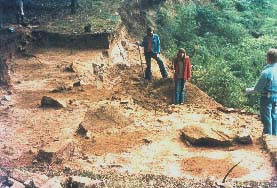
The Volkmarshausen dig, near Göttingen, where the red flint piece was found in 1980.
Already in the late Neolithic, therefore, the red silex was so much in demand, that men transported it across vast distances. Then came the flood. And later, someone must have discovered that the highest mountain tip still rose out of the waters in the shape of a lonely island. And someone must have still remembered that it was on this particular cliff that the unique, red silex could be found.
Heligoland
Siccles and daggers
"However this all came together – people were able to carry on regular expeditions across this wide expanse of sea in the direction of Heligoland in order to fetch the red silex there."
Towards the end oft he Neolithic, at the beginning of the Bronze Age, the long trip across the open waters became a truly lucrative trade. The seafarers brought back not only the red silex, but also the grey plate-flint. „It is less eye-catching,“ Nösler says, picking up a light-grey sickle, „but it is an outstanding material for the production of sharp sickles and daggers.“
This piece too stems from near Cuxhaven. The cutting-edge shines as if it had just been polished. "It has been used a lot,“ Nösler explains. "The so-called sickle-shine is created through the silica a very many times entering into contact with cereal stems."
When no loner in use, the tools made of Heligoland flint were not generally disposed of carelessly – they were kept in deposits. Many of them were found near salt springs, near river-mouths, in cultic or sacrificial places. The ax of the Wehrberg too lay at a special place. "This relatively visible elevation has been used as late as in contemporary times as a site to install navigational aids,“ Nösler says. And during prehistoric times, it was used as a burial site.
But why was the red Heligoland flint so highly valued? " We can only speculate about this,“ Nösler admits. "Maybe that the red color evoked blood.“ Or could it have been the special origin from the sunken land of Doggerland – from the cliffs which stuck out of the sea as a last reminder of the "Mesolithic heart of Europe"?
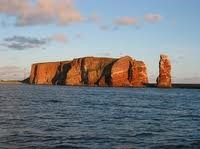
Angelika Frantz, Der Spiegel, 21.05.2015
Translated and adapted by Anne-Marie de Grazia
Heligoland flint - an exotic commodity in the Nordic Stone- Bronze- and Iron Ages
The flintstone of Heligoland is a godsend for archaology, as artifacts made out of it are usually easy to recognize with the naked eye and their origin can be defined precisely within kilometers.
Next to wood, bone and antlers, flintstone was the most significant commodity of the Stone Age in North-West-Middle Europe. It is suitable to the production of weapons and tools, thanks to its cleavability. Axes with knife-sharp polished edges, elegant daggers and speer-tips, stable-angled sickles and arrow-points could be produced. By means of a purposeful preparation of a core piece, series of long, regular blades could be cleaved off, which represented the beginning phase for a variety of tools. But for the fabrication of high quality instruments such as axes, daggers and sickles only freshly mined, little weathered flint is suitable, which in the Neolithic was to be found in areas without primary deposits close to the coast. At the time of the Late Paleolithic or Mesolithic, high quality surface deposits were also used, which were found on river banks and sea coasts. They made the production of long, regular blades possible, as well as of core- and blade axes.
Since 1979, geologists have been distinguishing five varieties of Helgoland flint, of which only two are suitable for tools production., the red flint and the plate-flint.
Red flint and red-flint tools
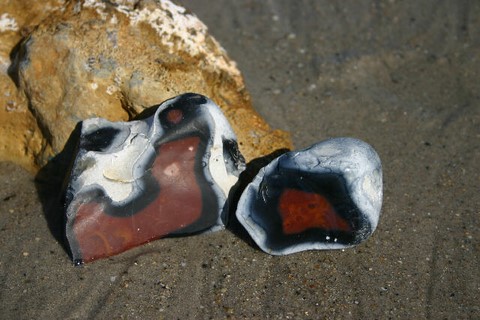
The red flint is mostly found in form of nodules or chunks between 8cm and 15cm in size. Rarely, nodules of 20 cm to 25 cm diameter can be found. The characteristic red color varies betweens tones of blood-red, purple-red and pink and occurs through high concentrations of iron-III-oxyde. Many nodules display, directly under the crust when broken, brown to orange-colored lines and dots as well as small circles, which resemble pressure cones. The silex is fine-grained and of little transparence, in many nodules there is a black area under the crust constituted by sulphur-iron combinations.
Further characteristics of the red Helgoland silex are white or brown to orange-brown inclusions, the surrounding areas of which are sometimes more fine-grained and appear lighter than the inside areas. The border between the inclusion on the red stone can be sharp, but occasionally there is also a transition area resembling a "crown of lights," made of small points. There are no bryozoen. The red flint has good working characteristics.
Contemporary isolated finds in Northern Germany and the Netherlands document the use of the red flint at the end of the last ice-age already, across Neo-and Late Palaeolithic culture groups. To these early artifacts belong a federmesser-culture scraper, a double-pole blade core-stone, and several single blades from late Palaeolithic collections.
In the Neolithic and the following Bronze Age, large nodules of red flint must have been mined from primary deposits. The latest overview shows a broad palette of tools which entered trade as finished products. Mere flakes and blades or specific waste products in the production of tools occur much more rarely. The scope of the tools reaches from Middle-Neolithic polished axes and chisels over simple scrapers all the way to queer-cutting arrow-points. From the late Neolithic and the Bronze Age, we have daggers, sickles and surface-enhanced arrow-points.
Plate-flint and plate-flint tools
Plate-flint nodules are widely available on the Heligoland Dune. This variety consists of flat concretions, several centimeters thick, with diameters up to 30-40cm. The color of the core is grey to greyish-black, pale-brown color tones occur regularly. Characteristic round spots 0,2 mm to 1 mm, often with sharp borders, in pale, milky-white colors are to be found. Close-up, the silex matrix shows small dots concentrating in the area of inclusions. They often are found in the area of a rather narrow band, circling the inclusions.
Fossil inclusions in the form of sponge pricks occur regularly; there is even a variety of plate-flint which is shot full-through with these; bryozoan are totally lacking. The surface is more or less smooth, but occasionally displays weld-shaped excrescences. There is no crust formed.
The raw nodules in sizes up to 40cm are very well suited thanks to their flat shape and high quality to the fabrication of leave-shaped, blade-shaped implements. They are totally unsuited for the production of long, regular blades. The most frequent tools made of Heligoland plate-flint are daggers and axes, small tools are up to now little represented.
The significance of Helgoland flint for archaeological research
Thanks to the distribution of artefacts made out of red Helgoland flint the wandering patterns and communication zones of ice-age hunter groups can be made out. The finds of plate-flint tools and of red Heligoland flint give indications about transport systems, trade routes and trade-networks, which were used between the 4th and 1st millennium BC. It is still unclear if the dispersion of the red flint occurred overland in Schleswig-Holstein (Eiderstedt Peninsula, North Frisian islands) towards the North (Denmark) and South (Netherlands), or if there existed direct trading routes for receiving-end areas South of the Elbe.
Based on contemporary reconstructions of the North Sea levels since the last Ice Age, there is no doubt that Heligoland was an isolated island more than 8,000 years ago already, from which there was no land in sight over a distance of over 60km. It can be concluded from this that products made of red flint and plate-flint were transported over the open sea using seaworthy vehicles the construction-type of which remains totally unknown. The navigators entrusted with the transportation of this precious cargo must have had stable boats and good navigational skills in order to be able to reach this tiny Northsea island and to master their way back.
Literature and links
Beuker, J.R. 1988: Die Verwendung von Helgoländer Flint in der Stein- und Bronzezeit.
Die Kunde NF 39, 1988, 93-116.
Beuker, J.R. 1990: The importation of Heligoland-flint in the province of Drenthe
(The Netherlands). In: M.-R. Séronie-Vivien & M. Lenoir (eds.), Le Silex de sa Genèse à L’Outil.
Actes du V° Colloque International sur le Silex. (Vth International Flint Symposium).
Tome II. Bordeaux, 17 sept.-2 oct. 1987. (= Cahiers du Quaternaire No 17., 1990, 311-319.
Beuker, J.R. 2010: Vuurstenen Werktuigen. Technologie op het scherp van de snede.
Leiden 2010, 30-40.
Hartz, S. und Segschneider, M. 2011: Der rote Flint von Helgoland. Archäologie in Deutschland
1, 2011, 64-65.
Kühn, H.-J. 1979: Das Spätneolithikum in Schleswig-Holstein. Off a Band 40. Neumünster 1979.
Schmid, F. und Spaeth, C. 1979: Feuerstein-Typen der Oberkreide Helgolands, ihr stratigraphisches
Auftreten und ihr Vergleich mit anderen Vorkommen in NW-Deutschlands. Staringia 6, 1979, 35-38.
Flintsource.net
Jaap Beuker
Sönke Hartz
Hauke Jöns
Martin Segschneider
© Niedersächsisches Institut für historische Küstenforschung, Wilhelmshaven / www.nihk.de
from: http://www.nihk.de//downloads/5/helgolandflint_d.pdf
excerpts translated by Anne-Marie de Grazia


